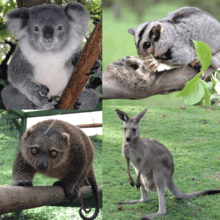Diprotodontia
Diprotodontia (from Greek "two forward teeth") is an order of about 155 species[2] of marsupial mammals including the kangaroos, wallabies, possums, koala, wombats, and many others. Extinct diprotodonts include the hippopotamus-sized Diprotodon, and Thylacoleo, the so-called "marsupial lion".
| Diprotodontia[1] | |
|---|---|
 | |
| Scientific classification | |
| Kingdom: | Animalia |
| Phylum: | Chordata |
| Class: | Mammalia |
| Infraclass: | Marsupialia |
| Superorder: | Australidelphia |
| Order: | Diprotodontia Owen, 1866 |
| Suborders | |
Characteristics
Living diprotodonts are almost all herbivores, as were most of those that are now extinct. A few insectivorous and omnivorous diprotodonts are known, and the Potoridae are almost unique among vertebrates in being largely fungivorous, but these seem to have arisen as relatively recent adaptations from the mainstream herbivorous lifestyle. The extinct thylacoleonids ("marsupial lions") are the only known group to have exhibited carnivory on a large scale.
Diprotodonts are restricted to Australasia. The earliest known fossils date to the late Oligocene, but their genesis certainly lies earlier than this, as large gaps occur in Australia's fossil record, with virtually no fossil record at all in geologically active New Guinea. The great diversity of known Oligocene diprotodonts suggests the order began to diverge well beforehand.
Many of the largest and least athletic diprotodonts (along with a wide range of other Australian megafauna) became extinct when humans first arrived in Australia about 50,000 years ago. Their extinction possibly occurred as a direct result of hunting, but was more probably a result of widespread habitat changes brought about by human activities—notably the use of fire.
Two key anatomical features, in combination, identify Diprotodontia. Members of the order are, first, "diprotodont" (meaning "two front teeth"): they have a pair of large, procumbent incisors on the lower jaw, a common feature of many early groups of mammals and mammaliforms. The diprotodont jaw is short, usually with three pairs of upper incisors (wombats, like rodents have only one pair), and no lower canines. The second trait distinguishing diprotodonts is "syndactyly", a fusing of the second and third digits of the foot up to the base of the claws, which leaves the claws themselves separate.[3] Digit five is usually absent, and digit four is often greatly enlarged.
Syndactyly is not particularly common (though the Australian omnivorous marsupials share it) and is generally posited as an adaptation to assist in climbing. Many modern diprotodonts, however, are strictly terrestrial, and have evolved further adaptations to their feet to better suit this lifestyle. This makes the history of the tree-kangaroos particularly convoluted: it appears that the animals were arboreal at some time in the far distant past, moving afterward to the ground—gaining long kangaroo-like feet in the process — before returning to the trees, where they further developed a shortening and broadening of the hind feet and a novel climbing method.
Fossil record
The earliest known fossil of Diprotodontia dates back to the Late Oligocene (23.03 - 28.4 million years ago), and the earliest identifiable species is Hypsiprymnodon bartholomaii from the Early Miocene.[4] In 2020 fossils of Mukupirna, meaning big bones was found. This is thought to be the ancestor of the Vombatiformes.[5]
Classification
Until recently, only two suborders in Diprotodontia were noted: Vombatiformes which encompassed the wombats and koala and Phalangerida which contained all other families. Kirsch et al. (1997) split the families into three suborders. In addition, the six Phalangeriformes families are split into two superfamilies.
Order DIPROTODONTIA
- Suborder Vombatiformes
- Family Vombatidae: wombats (three species)
- Family Phascolarctidae: koala (one species)
- Family †Ilariidae
- Family †Maradidae
- Family †Diprotodontidae: (giant wombats)
- Family †Palorchestidae: (marsupial tapirs)
- Family †Thylacoleonidae: (marsupial lions)[6]
- Family †Wynyardiidae
- Suborder Phalangeriformes
- Superfamily Phalangeroidea
- Family Phalangeridae: (brushtail possums and cuscuses)
- Family Burramyidae: (pygmy possums)
- Family †Ektopodontidae: (sprite possums)
- Superfamily Petauroidea
- Family Tarsipedidae: (honey possum)
- Family Petauridae: (striped possum, Leadbeater's possum, yellow-bellied glider, sugar glider, mahogany glider, squirrel glider)
- Family Pseudocheiridae: (ring-tailed possums and allies)
- Family Acrobatidae: (feathertail glider and feather-tailed possum)
- Superfamily Phalangeroidea
- Suborder Macropodiformes
- Family †Balbaridae: (basal quadrupedal kangaroos)
- Family Macropodidae: (kangaroos, wallabies and allies)
- Family Potoroidae: (bettongs, potoroos, and rat-kangaroos)
- Family Hypsiprymnodontidae: (musky rat-kangaroo)
† means extinct family, genus or species
References
Citations
- Groves, C. P. (2005). Wilson, D. E.; Reeder, D. M. (eds.). Mammal Species of the World: A Taxonomic and Geographic Reference (3rd ed.). Baltimore: Johns Hopkins University Press. pp. 43–70. ISBN 0-801-88221-4. OCLC 62265494.
- Meredith, Robert W.; Westerman, Michael; Springer, Mark S. (26 February 2009). "A phylogeny of Diprotodontia (Marsupialia) based on sequences for five nuclear genes" (PDF). Molecular Phylogenetics and Evolution. 51: 554–571. doi:10.1016/j.ympev.2009.02.009. PMID 19249373. Retrieved 5 May 2015.
- Tolweb
- The Paleobiology Database
- "Fossils of 'big boned' marsupial shed light on wombat evolution". The Guardian. The Guardian. 25 June 2020. Retrieved 25 June 2020.
- Naish, Darren. "Of koalas and marsupial lions: the vombatiform radiation, part I". Scientific American. Scientific American, Inc. Retrieved 24 October 2015.
Sources
- The Taxonomicon
- Mikko Haaramo
- Kear, Benjamin P.; Cooke, Bernard N.; Archer, Michael; Flannery, Timothy F. (November 2007). "Implications of a new species of the Oligo-Miocene kangaroo (Marsupialia: Macropodoidea) Nambaroo, from the Riversleigh World Heritage Area, Queensland, Australia". Journal of Paleontology. 81 (6): 1147–67. doi:10.1666/04-218.1.